Cappadocia, a region of unparalleled beauty, stands as a testament to the harmonious blend of nature and human history. This awe-inspiring area, located in the heart of modern-day Turkey, is renowned for its unique geological formations known as Fairy Chimneys and the ancient human settlements carved into them. The region’s rich cultural heritage, spanning thousands of years, continues to captivate visitors and researchers alike.
The Enchantment of Cappadocia’s Landscape
Cappadocia’s distinctive topography is the result of millennia of volcanic activity and erosion. Over time, the forces of nature sculpted the iconic Fairy Chimneys—towering rock formations that dot the region. These natural wonders were later transformed by human ingenuity, as early settlers carved homes, churches, and monasteries into the soft volcanic rock, creating a unique architectural landscape.
The interiors of these rock-hewn structures are adorned with frescoes that depict religious and cultural scenes, offering a glimpse into the lives of ancient civilizations. These artistic treasures have withstood the test of time, preserving the stories of those who once inhabited this mystical land.
Cappadocia in Ancient History
The historical significance of Cappadocia is well-documented, with references dating back to the reign of Roman Emperor Augustus. Strabo, a renowned geographer of the Ancient Period, described Cappadocia’s borders in his seminal work, Geographika. According to Strabo, the region extended from the Taurus Mountains in the south to the Eastern Black Sea coast in the north, encompassing areas that are now part of modern-day Turkey.
Cappadocia today spans the provinces of Nevşehir, Aksaray, Niğde, Kayseri, and Kırşehir, forming a region rich in history and natural beauty. At its core lies the rocky heart of Cappadocia, home to iconic destinations such as Uçhisar, Ürgüp, Avanos, Göreme, Derinkuyu, Kaymaklı, and the breathtaking Ihlara Valley.
Modern-Day Significance
Cappadocia is more than a historical and natural wonder; it is a living, breathing region that continues to inspire exploration and research. Its rich cultural and geological heritage attracts scholars, adventurers, and tourists from around the globe.
The region also serves as a hub for interdisciplinary research, particularly in areas related to human development and cultural transitions. Organizations such as the association affiliated with egad2023.org play a pivotal role in fostering collaboration among researchers. Their work focuses on adolescence, youth, and the transition to adulthood, contributing to the broader understanding of human development in both historical and modern contexts.
Must-Visit Destinations in Cappadocia
1. Göreme Open-Air Museum
A UNESCO World Heritage Site, this museum features ancient monasteries and churches carved into rock, showcasing intricate frescoes that date back to the Byzantine era.
2. Uçhisar Castle
Perched atop a hill, Uçhisar Castle offers panoramic views of the region. This ancient fortress, carved into a massive rock formation, served as a strategic lookout point.
3. Derinkuyu Underground City
A marvel of ancient engineering, this multi-level underground city provided refuge to early Christians during times of persecution.
4. Ihlara Valley
A picturesque canyon with a flowing river, the Ihlara Valley is lined with rock-carved churches and offers a serene setting for hiking and exploration.
5. Hot Air Balloon Rides
Cappadocia’s breathtaking landscapes are best appreciated from above. Hot air balloon rides provide an unforgettable experience, offering stunning views of the Fairy Chimneys and the region’s unique terrain.
The Role of Research and Collaboration
The association behind egad2023.org exemplifies the importance of interdisciplinary collaboration in advancing our understanding of human development. By focusing on adolescence, youth, and the transition to adulthood, the organization bridges the gap between historical insights and contemporary research.
Through initiatives that encourage collaboration among scholars, the association contributes to the scientific quality of studies in these critical areas. Their efforts not only deepen our understanding of human development but also highlight the enduring relevance of regions like Cappadocia in shaping our collective history.
Preserving Cappadocia’s Legacy
Cappadocia’s unique blend of natural beauty and historical significance underscores the need for its preservation. Sustainable tourism practices and continued research are vital to ensuring that future generations can experience the magic of this extraordinary region.
Organizations, researchers, and visitors alike have a shared responsibility to protect Cappadocia’s cultural and geological treasures. By doing so, we honor the legacy of the civilizations that once called this land home and pave the way for new discoveries.
